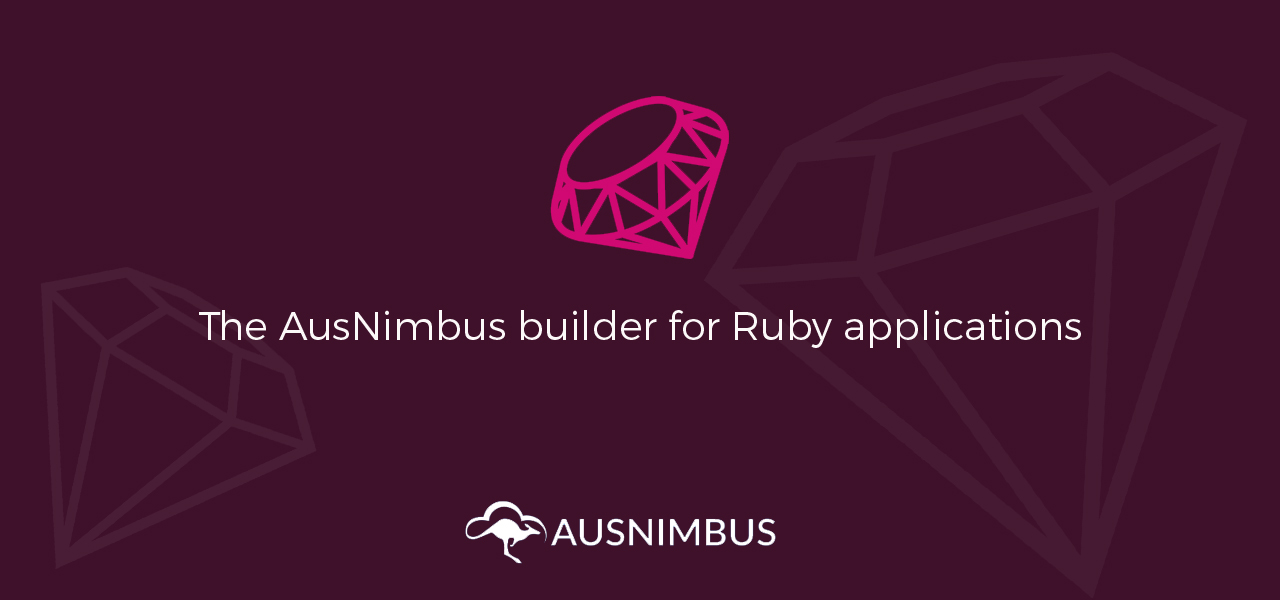The AusNimbus builder for Ruby applications provides a fast, secure and reliable Rack, Rails and Ruby hosting environment.
This document describes the behaviour and environment configuration when running your Ruby apps on AusNimbus.
- Runtime Environments
- Web Process
- Dependency Management
- Environment Configuration
- Advanced
- Extending
- Debug Mode
- Troubleshooting
AusNimbus supports various Ruby versions.
The currently supported versions are 2.1, 2.2, 2.3, 2.4
Your application's web processes must bind to port 8080.
AusNimbus handles SSL termination at the load balancer.
The recommended webserver is Puma and supports automatic optimization.
The builder uses the bundler for installing dependencies.
The following environment variables are available for you to configure your Ruby environment:
| NAME | Description |
|---|---|
| RACK_ENV | The Ruby application environment. (Default: "production") |
When your app is running in RACK_ENV=production, the asset compilation task will be run by default.
If you wish to skip this process you may set the following environment variable:
| NAME | Description |
|---|---|
| DISABLE_ASSET_COMPILATION | Set this variable to TRUE will skip the asset compilation process. |
If you would like to use a custom rubygem mirror you may use the following environment variable:
| NAME | Description |
|---|---|
| RUBYGEM_MIRROR | Set this variable to use a custom RubyGems mirror URL to download required gem packages during build process. |
By default the builder will check to see if ./config/puma.rb exists. If it does not exist the default builder provided config will be used.
You may alternatively specify another location for your puma config:
| Name | Description |
|---|---|
| PUMA_CONFIG | Path to your puma.rb config file. |
If you are using the builder provided (fallback) Puma config we automatically tune the number of workers for you based on the app instance size.
| Size | Value |
|---|---|
| Small | 2 Workers |
| Medium | 4 Workers |
| Large | 8 Workers |
| 2xLarge | 16 Workers |
You may optionally change these default settings by configuring the following environment variable:
| NAME | Description |
|---|---|
| WEB_CONCURRENCY | Set the number of Puma workers. By default, it is calculated as above. |
If you are not using the default Puma config the calculated WEB_CONCURRENCY variable is still made available to you.
AusNimbus builders are split into two stages:
- Build
- Runtime
Both stages are completely extensible, allowing you to customize or completely overwrite each stage.
If you want to customize the build stage, you need to add the executable .s2i/bin/assemble file in your repository.
This file should contain the logic required to build and install any dependencies your application requires.
If you only want to extend the build stage, you may use this example:
#!/bin/bash
echo "Logic to include before"
# Run the default builder logic
. /usr/libexec/s2i/assemble
echo "Logic to include after"If you only want to change the executed command for the run stage you may the following environment variable.
| NAME | Description |
|---|---|
| APP_RUN | Define a custom command to start your application. eg. rack --host 0.0.0.0 --port 8080 |
NOTE: APP_RUN will overwrite any builder's runtime configuration (including the Debug Mode section)
Alternatively you may customize or overwrite the entire runtime stage by including the executable file .s2i/bin/run
This file should contain the logic required to execute your application.
If you only want to extend the run stage, you may use this example:
#!/bin/bash
echo "Logic to include before"
# Run the default builder logic
. /usr/libexec/s2i/runAs the run script executes every time your application is deployed, scaled or restarted it's recommended to keep avoid including complex logic which may delay the start-up process of your application.
The recommend approach is to set your environment variables in the AusNimbus dashboard.
However it is possible to store environment variables in code using the .s2i/environment file.
The file expects a key=value format eg.
KEY=VALUE
FOO=BAR
The AusNimbus builder provides a convenient environment variable to help you debug your application.
| NAME | Description |
|---|---|
| DEBUG | Set to TRUE will enable common debug settings |
In order to dynamically pick up changes made in your application source code, you need to make following steps:
Run the built Rails application with the RAILS_ENV=development or DEBUG=true environment variable
Your application needs to be built with one of gems that reloads the server every time changes in source code are done. Some examples are:
